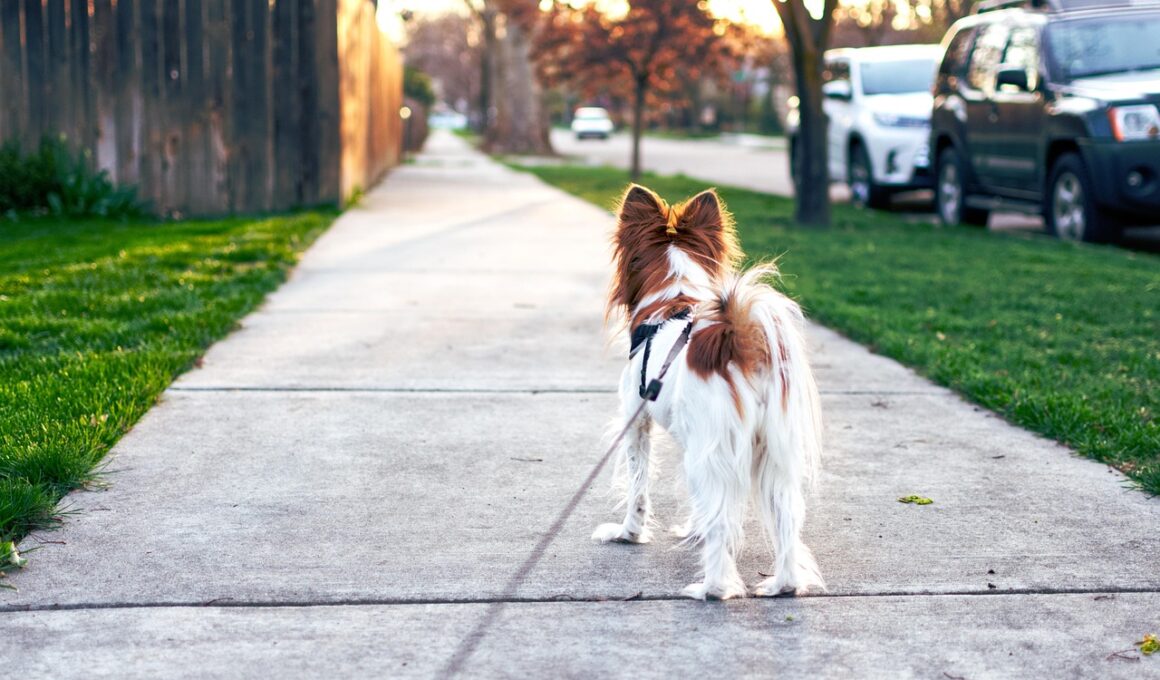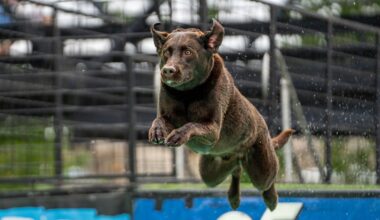Training Your Dog to Walk Calmly and Safely on a Leash
Training your dog to walk calmly and safely on a leash is essential for every dog owner. A well-trained dog not only enhances the walking experience but also ensures safety for both the dog and the owner. The first step to successful leash training is to choose the right leash and collar. Opt for a durable leash that offers good grip and control. Using a collar that fits comfortably and doesn’t cause choking during walks is also important. Start the training sessions in a controlled environment. Popular areas include your backyard or a quiet street. This will help your dog become accustomed to walking on a leash without the distractions found in busier settings. Practice basic commands like ‘heel’ and ‘stay’ before venturing out into busier areas. Consistency is key. Training sessions should be frequent yet short to maintain your dog’s attention. Positive reinforcement should be employed, rewarding your dog with treats or praises when they comply. Avoid punishing any undesired behavior; instead, redirect them gently with encouragement and affection during the walk.
Importance of Socialization
Socializing your dog is a pivotal part of leash training. When dogs are accustomed to various environments, they react positively to distractions during walks. Introduce your dog to a wide variety of people, other dogs, and different settings. New experiences can help reduce anxiety. If a dog is terrified of cars or people, it may react unpredictably. Gradual exposure to these elements teaches them to remain calm and composed while on a leash. During socialization, maintaining control is crucial. Start from a distance where your dog feels comfortable, either sitting or standing beside you. Gradually decrease the space as your dog adjusts. This phased approach prevents overwhelming them. Engage with friendly dogs, allowing them to play and socialize. As your dog becomes more comfortable, gradually introduce the concept of walking past distractions, keeping your dog focused on you. Utilizing techniques such as clicker training can reinforce desirable behavior during these encounters. Ultimately, a well-socialized dog will become more relaxed, making walking with them a joy rather than a burden. Above all, remember that every dog is unique and may progress at their own pace.
Implementing leash training requires patience and creativity. Early on, your dog may pull hard or dart off suddenly in excitement. It’s essential to stay calm and collected. Instead of tugging hard on the leash, practice techniques that encourage them to ‘heel.’ One method involves stopping whenever your dog pulls. They will soon learn that pulling only leads to halting the walk, while walking by your side leads to treats and positive attention. This can be reinforced by rewarding them verbally and physically, encouraging them to stay close. Training aids like treats can enhance the effectiveness of this approach, ensuring that your dog associates being next to you with positive outcomes. It’s about establishing a bond and communication through these guided experiences. Aim to make leash training enjoyable rather than a chore for both you and your dog. As your dog becomes accustomed to this new behavior, slowly introduce more challenging environments. Practice walking where there are new sights and sounds but remain attentive to their comfort levels. With consistent and positive reinforcement, walking together will eventually evolve into a genuinely pleasurable experience for you both.
Addressing Common Challenges
While leash training, you may encounter various challenges along the way. Dogs can be unpredictable, and they might react to sudden sounds, animals, or smells. Distractions can lead to your dog pulling on the leash or refusing to follow your commands. To overcome this, use short, focused training sessions in such environments. Reward your dog immediately when they focus on you instead of distractions. As your dog gains more confidence, gradually introduce more bustling surroundings. Another common challenge is reactivity towards other dogs. Some dogs become overly excited or aggressive when they see another dog. Prepare for this by practicing impulse control commands. Teach them to ‘sit’ or ‘stay’ before encountering the other dog. This practice will help them learn to remain calm. If they show signs of excessive excitement or aggression, redirect their attention back to you. A special toy or high-value treats can be useful tools for this. Creating distance from triggering stimuli initially can also help until your dog learns to manage their reactions better. Consistent reinforcement and training will ultimately help them understand better responses to such situations.
Continuing your leash training as your dog matures is highly advisable. As they grow older, their energy levels and behavior may change, requiring regular reassessments of your training strategy. Continuous practice will ensure that your dog remains obedient and well-behaved on walks. Incorporate a variety of environments and distractions into your routine. This could mean taking different routes or introducing them to other animals or people. This diversification keeps training engaging. Agreeing on commands with family members increases consistency; everyone should use the same commands and techniques to reduce confusion. Also, periodically reassessing your dog’s equipment, such as the leash and collar, is crucial to ensure comfort and safety. If the gear no longer fits or appears worn, invest in new equipment that suits their current size and needs. Maintenance is vital for safety during walks. Make walking a daily ritual as much as possible, making it something for them to look forward to. Engaging with them beforehand can set a positive tone for the walk. By nurturing this relationship, walks can transform into enjoyable bonding times that contribute positively to your dog’s overall behavior.
Staying Safe During Walks
Safety is paramount when spending time outdoors with your dog. Understand the area you plan to walk in, including potential hazards such as busy roads, aggressive dogs, or wildlife. Always keep your dog on a leash in public places, which is not only a legal requirement in many places but also an effective way to prevent runaway situations. Choose a sturdy leash that allows for easy control especially when encountering distractions or risks. Equipping your dog with a properly fitted harness can offer better control and prevent choking, especially for reactive or larger breeds. Regularly check your dog’s behavior. If they show signs of stress or panic, like barking excessively or trying to escape the leash, practice calming techniques during walks to ease their anxiety. Carry a first aid kit for dogs, which can handle minor injuries sustained during walks. Remember to provide water breaks, especially on warm days. Keeping your dog hydrated ensures they remain energetic and happy during your outings. Following these steps keeps both you and your canine companion safe while enjoying memorable adventures together.
In conclusion, training your dog to walk calmly and safely on a leash can significantly enhance the time shared together. This process not only promotes a strong bond between you and your dog but also cultivates a respectful relationship built on trust and understanding. Dedicate time to explore positive reinforcement techniques to foster good behavior on walks. Regular practice and socialization are critical components in achieving a well-behaved dog. Remember to be patient; every dog learns at its own pace. Stay committed to the process, and don’t be discouraged by setbacks. Incorporating variety in your training routines keeps both you and your dog engaged and motivated. Emphasizing safety cannot be overstated; always prioritize secure leash attachment and appropriate equipment. Make your walks enjoyable by exploring new routes and varying your social interactions. Ultimately, the reward for your efforts will be a well-trained, happy dog that can enjoy walks without stress or fear. Get ready to embark on countless joyful adventures, knowing that both you and your furry friend are prepared for a safe and rewarding experience wherever you may go.


